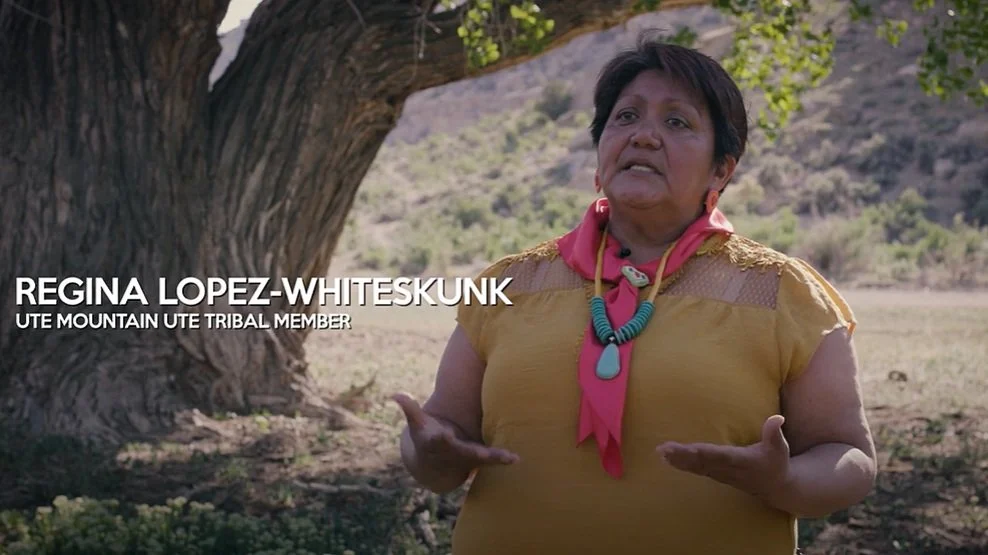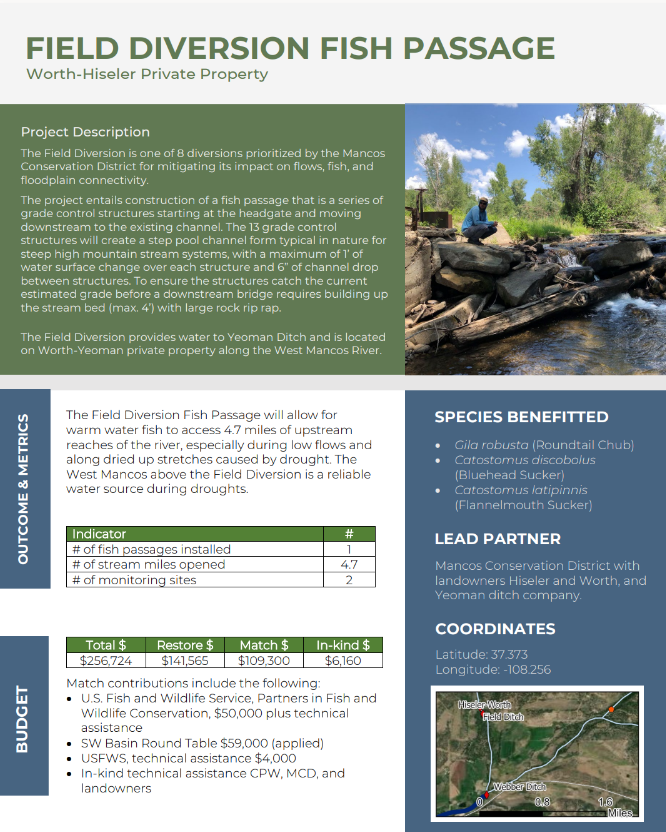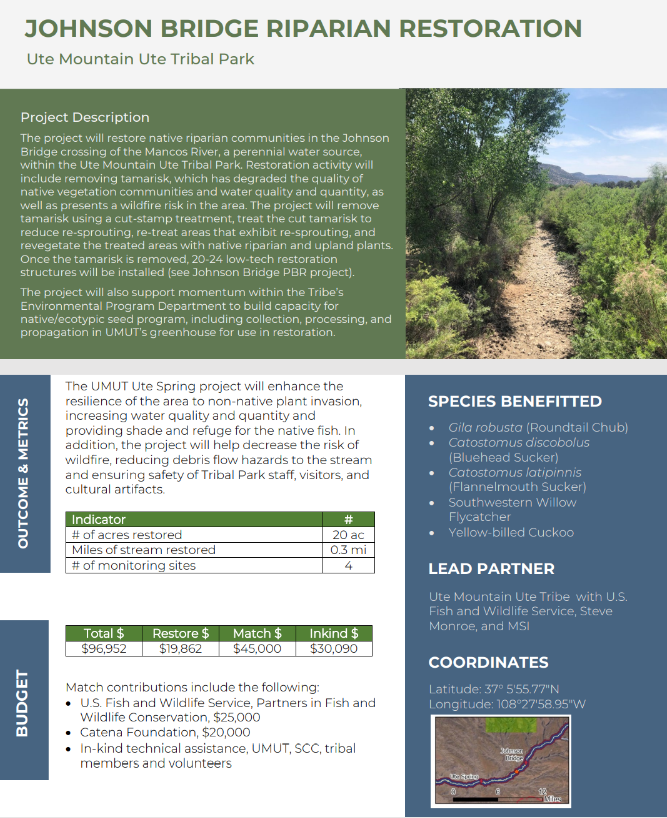The Restoring Riparian and Instream Habitat on Mancos River to Improve Connectivity for Native Fish (CO) project involves Mountain Studies Institiute with the National Fish and Wildlife Foundation. This project will benefit imperiled warm water native fish: Roundtail Chub, Bluehead Sucker and Flannelmouth Sucker.
Project Summary:
The Mancos River is a unique tributary of the San Juan and Colorado rivers for conservation: (1) native warm water fish are protected from predators by an impassible barrier near the San Juan confluence, and (2) 65% of the watershed is on the Ute Mountain Ute Reservation, one of Colorado’s two federally recognized tribes. River flows have declined by 60%, which dries up by July due to diversions and drought.
The Restoring Riparian and Instream Habitat on Mancos River to Improve Connectivity for Native Fish will benefit the imperiled Roundtail Chub, Bluehead Sucker and Flannelmouth Sucker while improving in-stream and riparian habitat for other wildlife, beneficiary communities, and Ute Mountain Ute Tribe who values the water, cottonwoods, and native shrubs our project will restore. We will rectify 2 fish passage barriers, open access to 16 miles of stream for refugia, restore 1.34 miles of stream geomorphology and aquatic habitat, restore 11.32 acres of floodplain, and treat 40 acres for tamarisk.
To achieve the outcomes, activities will: 1) Connect fish to in-stream habitat and improve hydrology; 2) Restore riparian habitat and revegetate degraded floodplains; and 3) Build cross-community capacity for restoration, sustainability, and scaling. Eight projects build on Phase 1 activity, span multiple jurisdictions (public, private, Tribal) and are prioritized in regional plans. Partners are the Ute Mountain Ute Tribe, Mesa Verde National Park, and Mancos Conservation District.
Below is MSI’s YouTube video on the RESTORE Project
For more details of the project, click the images below
Mancos River Restoration and Resilience
The Mancos River Restoration and Resilience Group (MRR) is a science working group formed by stakeholders with a shared interest to understand the current status of the Mancos River and identify opportunities to for restoration and building resilience in the watershed. Since its start in 2014, the group has collaborated to gather existing data, summarize the current state of the river, identify information needs, and select priority actions to. Mancos Conservation District and Mancos River Watershed Group are compiling existing data in order to assess the resilience of the Mancos River in meeting multiple uses and values in the face of changing climate conditions.
In 2020, the group completed a project “Drought Resilience for the Mancos Watershed.” To support land and resource managers in addressing the challenges and uncertainty of drought in the region, we developed a process that integrates existing best practices and research to identify and prioritize locally relevant, climate-informed drought resilience strategies across multiple values. Through an iterative, multi-stakeholder effort, we integrated innovations in participatory approaches and scenario planning with a structured decision support framework. Specifically, the decision support framework entailed the following steps:
Identify community concerns, challenges, and questions, and develop shared values.
Define key vulnerabilities and stressors under future climate scenarios both spatially and narratively
Determine specific and shared goals for the persistence of each of those values.
Brainstorm additional strategies for achieving goals associated with each value (both existing and potential strategies).
Rank and prioritize strategies; identify spatially explicit opportunities for implementation in identified sub-reaches
In the process, it was clear that the Mancos Watershed and the values that stakeholders identified are highly vulnerable to changing climate conditions, that there are actions we can take to reduce those vulnerabilities, and that where we work within the watershed matters when it comes to where we will have the greatest impact. While this effort alone does not constitute a complete drought resilient plan for the Mancos Watershed, the drought resilience decision framework will help managers both consider and demonstrate the integration of climate-informed strategies into deciding what actions to take and where to take them across the entire watershed. The process may be applied to additional conservation values to integrate drought-informed thinking into existing investments and future management plans and could also be adapted for use in other watersheds or regions.
Read the plan here.
For additional information, please visit www.mancoscd.org.
The MRR Steering Committee guides the efforts of our collaboration: directs the collection of existing data and data gaps assessment, provides direction for the Mancos River Assessment, and assists with stakeholder engagement in the development and delivery of the report. The Steering Committee is open to anyone who would like to support its function. To volunteer, contact Page (page@mountainstudies.org).
RESOURCES
Visit our Dropbox
Get email updates (melissa@mountainstudies.org)
Reports and Plans
Prioritized Drought Resilience for the Mancos Watershed, Final Report, 2021
Drought and Change in the Mancos Watershed, Final Report, 2019
Mancos Watershed plan, 2011













